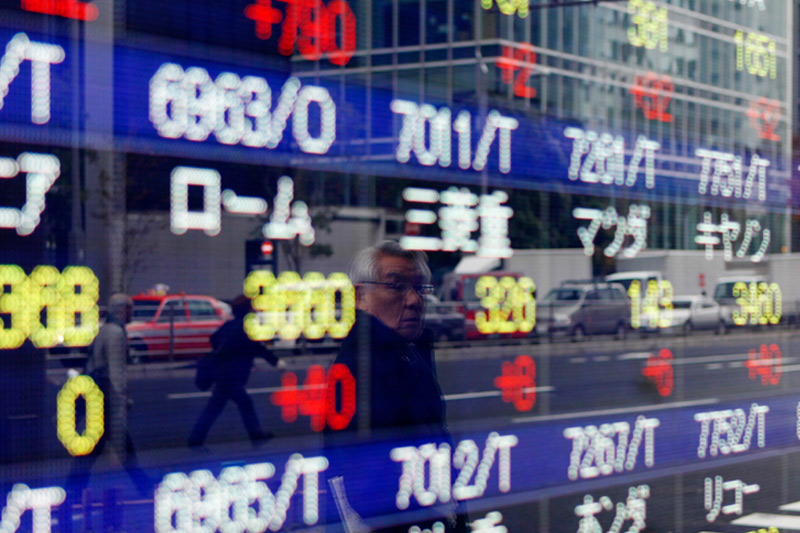By Wayne Cole
SYDNEY (Reuters) - Asian shares came under pressure on Thursday as a disappointing survey on Chinese manufacturing stoked concerns about the regional giant and overshadowed better news from Japan.
The HSBC/Markit Flash China Manufacturing Purchasing Managers' Index (PMI) fell to 50.3 in August from July's 18-month high of 51.7, badly missing a Reuters forecast of 51.5.
Investors reacted by selling the Australian dollar <AUD=D4>, often a used as a liquid proxy for bets on China, while shares in Shanghai dropped 0.5 percent (SSEC).
MSCI's broadest index of Asia-Pacific shares outside Japan (MIAPJ0000PUS) skidded 0.6 percent, with indices in South Korea (KS11) and Taiwan (TWII) in the red.
Yet Japanese shares managed to buck the trend aided by a survey showing manufacturing activity accelerated in August as export and domestic demand increased.
The Markit/JMMA flash Japan PMI jumped to a seasonally adjusted 52.4, up from 50.5 in July and the highest reading since March just before a hike in taxes sent demand cratering.
Tokyo's Topix (TOPX) was still up 0.8 percent, while the Nikkei (N225) gained 0.9 percent. They had started firmly after the yen took a spill against the U.S. dollar, in a positive sign for Japanese exports and corporate earnings.
The dollar was up across the board as investors detected a hawkish turn in policy discussions at the Federal Reserve.
Yields on short-term U.S. debt had leapt by the most since March as minutes of the Fed's last meeting led markets to price in a greater risk of an earlier hike in interest rates.
The story was much the same in Britain where bond yields jumped on news that two Bank of England policymakers unexpectedly broke rank with colleagues and voted for higher interest rates earlier this month.
The U.S. dollar index, which measures the greenback against a basket of six major currencies, climbed further to 82.334 after breaking decisively higher overnight.
The dollar also notched up a four-month peak against the yen at 103.96 <JPY=>, while the euro <EUR=> crumbled to an 11-1/2-month trough of $1.3243.
WHEN HAWKS CRY
On Wall Street, the Dow (DJI) had ended Wednesday up 0.35 percent, while the S&P 500 (SPX) gained 0.25 percent and the Nasdaq (IXIC) dipped 0.02 percent.
Equity investors seemed reassured that the vast majority of the Fed's voting committee wanted to keep a pledge that rates would stay near zero for a considerable time after it stops buying assets, which is expected in October.
But the minutes also revealed a more active debate about whether an earlier hike in rates might be needed.
"Our takeaway is that the median FOMC participant has been surprised by how quickly the unemployment rate has come down and is also less convinced there is as much slack in the labour market as previously believed," said Michelle Girard, chief economist at RBS.
"So the hawks are getting restless and the centrists seem to be less dug-in on some of their previously held views."
With cries of the hawks ringing in their ears, bond investors chose to punish Treasuries. Shorter-dated debt was hit hardest as it is typically more sensitive to expectations on changes in the official Fed funds rate.
Yields on two-year paper (US2YT=RR) shot up 5 basis points to 0.4757 percent, the biggest daily increase since March.
Fed funds futures fell as the market brought forward the timing of a first hike. Futures for June next year <0#FF:> now imply a rate of 27 basis points, compared to 23 basis points early in the week.
The current target for Fed funds is a range of zero to 25 basis points and it effectively trades at just 8 basis points.
Across the Atlantic, the risk of an early move by the BoE lifted yields on British two-year debt 4 basis points to 0.74 percent (GB2YT=RR).
That saw sterling hold up fairly well against the broadly firmer greenback and actually rise on the euro, which plumbed a one-week low at 79.68 pence (EURGBP=R).
In commodity markets, the rise in the dollar knocked gold down to $1,289.26 an ounce <XAU=>, and further away from last week's peak of $1,319.10.
Oil ran into renewed selling after a modest bounce on Wednesday. Brent crude for delivery in October was 22 cents easier at $102.06 a barrel, while U.S. crude lost 2 cents to $93.43.
(Editing by Shri Navaratnam and Eric Meijer)
